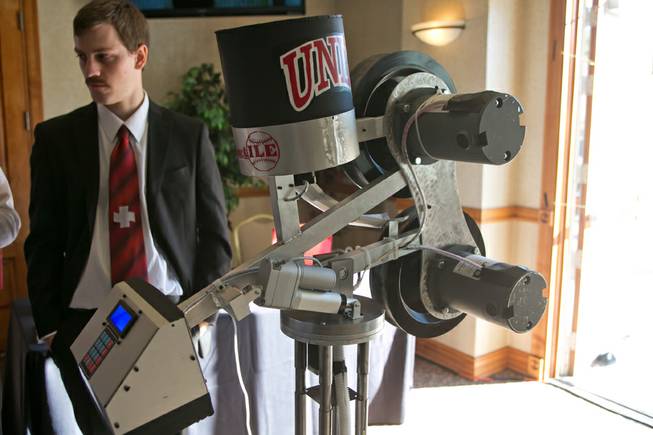
The Project-ILE, a multi-use pitching machine, is on display at the UNLV Fall 2013 Senior Design Competition on Thursday. Dec. 5, 2013.
Tuesday, Dec. 10, 2013 | 2 a.m.
A metal collecting rover and a clothing iron inspired by a hair-straightener were some of the unique inventions showcased at UNLV's engineering design competition this semester.
To graduate, all Hughes College of Engineering seniors must design and build a prototype for a new product with real-world applications.
Students use various engineering disciplines — civil, mechanical, electrical and entertainment — as well as computer-science and business savvy to come up with their inventions over the course of a semester or a year. They are given about $1,000 in seed money to complete their projects, which must demonstrate some commercial and market potential.
Twenty-four promising inventions were on display Thursday at Cox Pavilion. Judges from engineering colleges and firms evaluated each project, and competition winners will be announced at an awards ceremony in the spring.
Here are six inventions being developed:
-
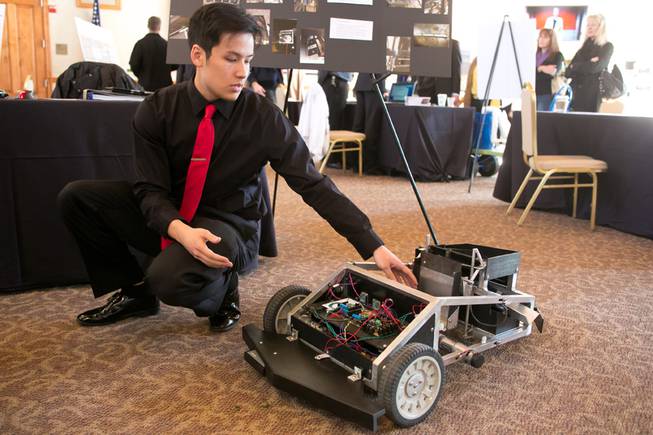
Autonomous Brass Collecting Rover
Mechanical engineering students Jameson Lee and Jared Peterson designed and created an autonomous rover that could collect spent bullet shell casings to be recycled. After military drills, there could be as many as 12,000 spent shells left behind on shooting ranges that are currently collected by hand, according to the students.
The four-wheel rover, which is equipped with GPS, moves on a pre-programmed path around a gun-shooting range or military training course. The rover uses a front-mounted metal detector and scoop to collect brass shells. A special electrical machine on the back of the rover sifts the brass casings from the rocks and dirt.
The students see the rover as a major benefit to local military and commercial gun shooting ranges.
-
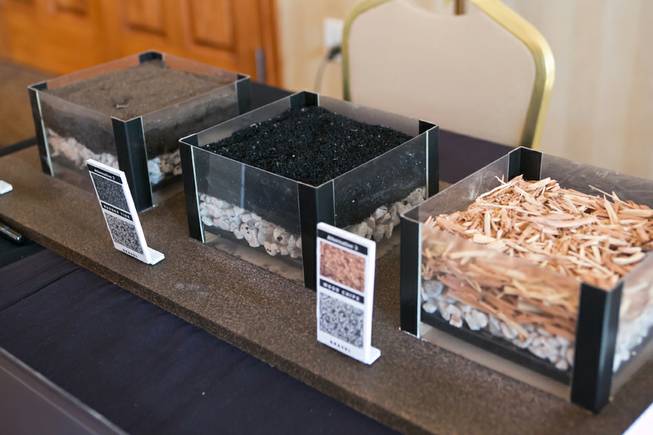
Wastewater filter
Civil and environmental engineering students John Gonzales and Robert Kazarin researched various wastewater treatment filters for the city of Las Vegas.
Hydrogen sulfide gas is a toxic pollutant created when wastewater is treated. Typically, wastewater treatment centers use biofilters, such as wood chips, compost and rubber tire chips, to remove the rotten-egg-smelling gas from the water. The Las Vegas wastewater treatment facility uses wood chips as its sole biofilter.
Gonzales and Kazarin tested several combinations of biofilters and found compost and gravel removed the hydrogen sulfide gas from the effluent most effectively. They plan to present their findings to Las Vegas water officials soon.
-
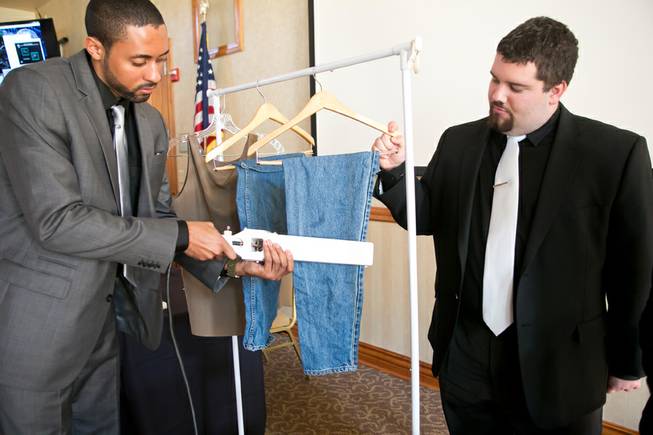
Consolid Iron
Mechanical engineering students Emily Black, Ron Duprau and CJ Murray designed and developed a new hand-held clothing iron that was inspired by a hair-straightening iron.
Black said she came up with the idea for the new clothing iron design when she was rushing to get ready one morning and realized her dress shirt was wrinkled. She had just straightened her hair, so she took her hot hair-straightener to the wrinkled fabric and realized it could also iron her clothes.
Unlike a traditional iron, the “Consolid Iron” saves time because it doesn’t need an ironing board. The iron presses clothing hanging from a clothes hanger, eliminating the need to iron both sides of a shirt or pants. The iron’s temperature can be set up to 380 degrees to treat a wide range of fabrics, including cotton, nylon, silk and wool. It takes only a couple of minutes to heat up and is encased in Teflon material to prevent burns.
The students hope to bring their product to market. They estimate their Consolid Irons will sell for about $50 each.
-
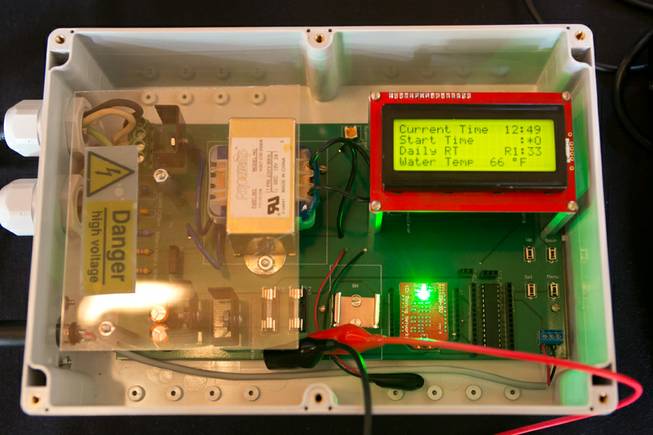
Eco Pool Pump Controller
Electrical and computer engineering students Jimmy Benoit and Aleksandar Jovkovic designed and created a more efficient pool pump that uses a sensor to measure the water temperature to calculate how often water must be filtered.
Pool water must be filtered for bacteria and contaminants, but how often depends on the season. During the cooler months, pool pumps don’t need to run as often. However, most pool pumps run on a set schedule year-round, wasting electricity, according to Benoit, who owns a pool.
The Eco pump controller, which has a temperature sensor and special energy-management software, can replace an existing pool pump controller to save Las Vegas pool owners money. The students estimate their pump, which would retail for about $200, could save homeowners up to $300 a year. The Eco pump also can be controlled by a smartphone app, allowing owners of vacation homes to control their pool pumps remotely.
-
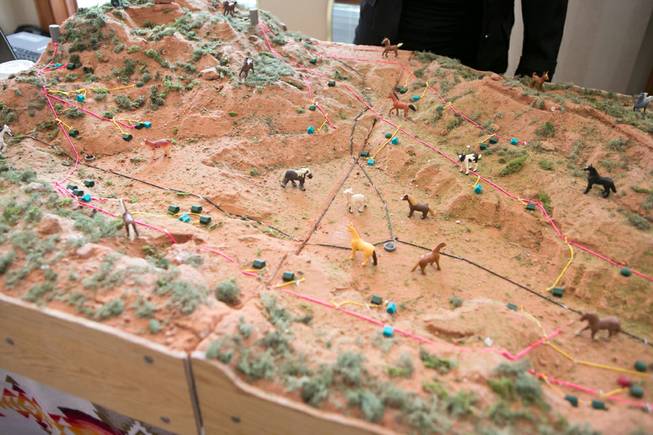
KoKo To’bii’yii Waterline Sustainability Project
Civil and environmental engineering students William Avery, Adrian Gebilaguin, Henry Pangelinan and Calista Tsinnijinnie designed a new running water pipe and sewage system for a Navajo reservation in Arizona.
The Navajo Nation has a population of nearly 174,000 in parts of Arizona, Utah, Colorado and New Mexico. About 40 percent of the population doesn’t have access to running water and adequate sewage management amenities.
Tsinnijinnie, who is from a Navajo reservation in Coppermine, Ariz., about 25 miles from Lake Powell, said she and her team worked with the Indian Health Services department to develop a design for the water and sewer line that could be used by the 56 homes in her hometown.
The students’ design consists of 262,000 linear feet of water piping and two water wells, which would go up to 700 feet underground to tap into an aquifer and use solar-powered pumps to bring water to the surface. In addition, Coppermine residents are encouraged to collect rainwater through a UNLV-designed system.
The project is expected to cost about $4.2 million, within the Navajo and federal government budget.
-

Automated Sports Ball Launcher
Mechanical engineering students Robert Callahan, William Calloway, Marvin Lemus and Philipp Maeder designed and created a cheaper and more versatile pitching machine that can be used for all sports.
Most baseball pitching machines cannot move and change pitches, or handle a variety of balls, such as softballs and tennis balls, according to the students.
The Automated Sports Ball Launcher, which can be controlled via a software program, can be used for batting, fielding and tennis ball hitting practice. The ball launcher can throw ground balls and pop-flies and change directions to make practice interesting.
The machine, which took about eight months to develop, would cost about $4,000 if it goes to market, according to the students.
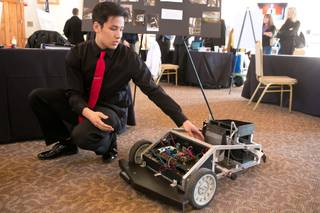






Join the Discussion:
Check this out for a full explanation of our conversion to the LiveFyre commenting system and instructions on how to sign up for an account.
Full comments policy